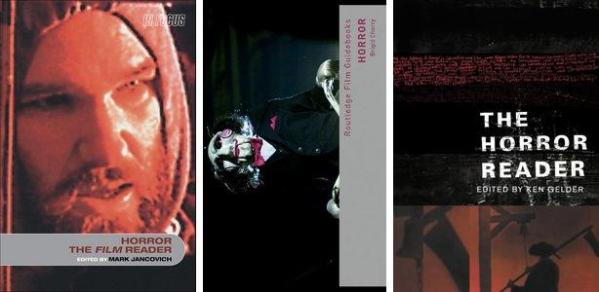DISCLAIMER: These aren’t really dark tomes, but that’s a popular horror cliche trope, after all.
I’m not absolutely certain, but I think this semester will mark my fourth time to teach the Horror Film course (officially called COM105.9: Film Seminar – The Horror Film). While warnings abound about fixing something that isn’t broken, I believe every course can be improved, even without needing actual fixing.
My most immediate concern is the course text, i.e., the book from which I will assign readings for my students. I’ve always used Mark Jancovich (ed.)’s Horror, The Film Reader (the leftmost cover with Kurt Russell from The Thing on it), but I’m now wondering if I should change to Brigid Cherry’s Horror or Ken Gelder (ed.)’s The Horror Reader:

From left to right: Mark Jancovich, Brigid Cherry, Ken Gelder.
The Jancovich is my tried-and-tested text. I’ve gotten so used to teaching with it that its contents have pretty much settled in my head as THE way to approach the course: Start with Robin Wood, follow up with Noel Carroll’s rebuttal, proceed to gender first with the gaze and then the abject, etc.
The way I see it, my comfort with the text and the pedagogical assumptions that underpin it is precisely the reason why I need to reassess my use of it. Still, old habits are like John McClane, if you pardon the mixed genres.
(Also, there’s the symmetry between the number of readings in Jancovich and the 14 meetings I have for the course this semester.)
If I want a different approach, I have Gelder’s anthology to consider. Double the number of essays in the Jancovich (29, to be exact), there’s surprisingly little overlap between the Gelder TOC and that of the Jancovich, save two or three pieces.
Just as important is the sheer number of sections, which present a more interesting structure for teaching the course. It also helps to group related essays together and assign the eleven parts during the semester.
The downside is one that my students will easily point out, however, there’s too much to read. While I haven’t seriously gone through the Gelder, I already get complaints about the difficulty of some of the readings in Jancovich. The Gelder seems even more prone to that kind of complaint.
I don’t want to go too easy though, because there certainly is a need to struggle with Barbara Creed’s discussion of the “monstrous-feminine” no matter how difficult it is when compared to, say, Robin Wood on “the return of the repressed.”
Now that I’ve written all these, I’m beginning to see how much I prefer assigning anthologies with readings that disagree with each other. The students aren’t going to get that with a single-author work like the Brigid Cherry Routledge Film Guidebook simply entitled Horror. With only four lengthy chapters, this is keeping things simple.
That’s not a bad thing, at least in this situation.
Ideally, a specialized film course like this one should be dependent on a prerequisite foundational course with a broader scope. In reality, this is an open elective, and I often get students who have never taken a film course ever.
The Cherry book is broad enough to be foundational, unlike the particular theories and schools of thought in the Jancovich and the Gelder, which clash and clang with each other.
Still, it’s a film course, unfortunately already presupposed by many to be easy-A, at least where I teach. Challenging readings could address that false impression and, well, kill it once and for all.
If I had the time, to be honest, I’d probably mix and match essays found online with pieces from the Jancovich and the Gelder. Maybe even more specialized texts. (And I sometimes wish I could afford to be less general in my approach and just do, say, a specific course on psychoanalysis and horror.)
As it is though, this is only one of the things I have to think about with regard to the class. There’s also, after all, what to screen this time.